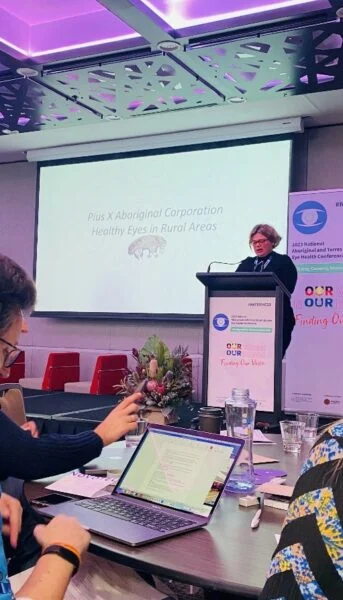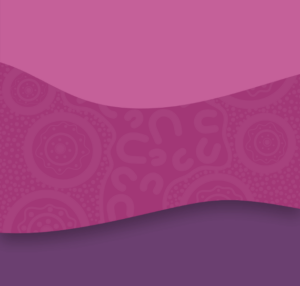The 2023 National Aboriginal and Torres Strait Islander Eye Health Conference (NATSIEHC23) was held on Dharug Country in Western Sydney from 24th – 26th May.
The conference theme ‘Our Vision in Our Hands: Finding Our Voice’ sought to highlight emerging and future First Nations leaders of the sector, while also resonating the strength and values of the longstanding movement for Aboriginal and Torres Strait Islander self-determination in health, and the broader current national movement to enshrine First Nations Voice to parliament.
NATSIEHC23 was the seventh annual, national conference and aimed to build on the collective work of the Aboriginal and Torres Strait Islander health sector to improve eye health access and outcomes for First Nations Australians. The conference was led by the National Expert Group in Aboriginal and Torres Strait Islander Eye Health (NEGATSIEH) and co-hosted by AH&MRC (Aboriginal Health and Medical Research Council, NSW).
Over 240 delegates attended the conference from all states and territories – this included over 100 First Nations delegates. Three days and over 50 presentations provided opportunity for connection and a rich sharing of wisdom and learnings. Delegates included representatives from Aboriginal Community Controlled Health Organisations and other primary care service providers, eye care clinicians, policy makers, researchers, non-government organisations, hospitals, professional peak bodies and government departments from across the country.
A brief overview article about NATSIEHC23
Keynote speakers:
- Lauren Hutchinson – 2023 Jilpia Nappaljari Jones Memorial Oration
- Donna Murray – Chief Executive Officer of Indigenous Allied Health Australia (AIHA)
- Renata Watene – Renata Watene is one only of a few Māori Optometrists in Aotearoa as an immerging Indigenous Eye Health Leader
- Karl Briscoe – CEO of the National Association of Aboriginal and Torres Strait Islander Health Workers and Practitioners (NAATSIHWP)
Opening Session – Day 2 (Full Program NASTIEHC23-PROGRAM_2023.05.23_FINAL.pdf (unimelb.edu.au)
Conference Co-Convenor – David Roberts, Aboriginal Health and Medical Research Council of NSW (AH&MRC) – on behalf of (Melissa Sutton

Conference Greetings – Kane Ellis, Illawarra Aboriginal Medical Service
PP2.3 Healthy Eyes in Rural Areas Author: Ann-Marie Thomas Abstract: Toomelah is a small Aboriginal Community on the QLD and NSW border , a population of 250 people, 100 percent Aboriginal population. Brien Holden Vision have been working in partnership for many years with Pius X Aboriginal Health Service providing a much needed service to the community. The community has no public transport, no shop and is 30kms form the nearest town, having this service come to the people is imperative. Brien Holden have also trained the Aboriginal Nurse and since her training she is doing screening in schools and have referred children to the optometrist clinic and we now have quite a few children wearing glasses and can now see the boards at school. We are dedicated to closing the gap in numeracy and literacy by ensuring the children have good vision. This screening process also seen a young 15 year old boy at risk of glaucoma. We are dedicated and proud of the partnership to improve vision in rural and remote communities.



The awards are aligned with the Conference theme – Our Vision in Our Hands: Finding our Voice – set by the National Experts Group for Aboriginal and Torres Strait Islander Eye Health NEGATSIEH), which contributes to the Conference Leadership Group.
This broad theme works to highlight and promote the importance of Aboriginal and Torres Strait Islander perspectives and leadership in the eye health sector locally and nationally. The theme also promotes the need for greater First Nations leadership through community-controlled services and evolving national governance mechanisms, including the call to enshrine an Indigenous voice into the Australian constitution.
We are pleased to open nominations for the 2023 awards, in the following categories:
- Contribution to Aboriginal and Torres Strait Islander eye health by Aboriginal Community-Controlled Health Organisations (ACCHO)
- Contribution to Aboriginal and Torres Strait Islander eye health (Individual)
- Aboriginal and Torres Strait Islander leadership in eye health
- Allyship in contribution to Aboriginal and Torres Strait Islander eye health
“A very special mention goes to Jenny and team at Walgett AMS for being awarded for their contribution to Aboriginal & Torres Strait Islander eye health “

Jenny Hunt, who accepted the award for Walgett Aboriginal Medical Service (WAMS)
The winner of the NATSIEHC 2023 award for Exceptional contribution to Aboriginal and Torres Strait Islander eye health by Aboriginal Community-Controlled Health Organisations (ACCHO) is: Walgett Aboriginal Medical Service
- From the nomination statement: The Walgett Aboriginal Medical Service (WAMS) was one of the first eye health locations within an Aboriginal Community Controlled Health Service in NSW to provide bulk billed optometry services to their community members, starting in 1999 through NSW Aboriginal Vision program, co-designed with the Aboriginal Health and Medical Research Council of NSW (AH&MRC) and the Brien Holden Foundation (then known as ICEE). The fruit of those early seeds of collaboration continue to flourish today.
- The nomination highlighted the dedication and commitment of WAMS management to eye health, as they have continued to fund a dedicated Eye Health Coordinator position since the very beginning of this program until today.
- The WAMS Eye Health Coordinator supports clinics in Walgett and outreach services at Lightning Ridge, Goodooga, Collarenebri, Narrabri, Wee Waa and Pilliga.
- Up until 2015 the WAMS Eye Health Coordinator serviced both the Walgett and Hunter New England regions, supporting over 30 outreach clinics. WAMS worked with the support of optometry provider the Brien Holden Foundation to hand some of the Western NSW and Hunter New England clinics over to the established Aboriginal Community Controlled Health Services in those communities.
- WAMS embraced eye health so much that they applied for infrastructure grants to establish a well-equipped dedicated eye health room. Local outreach patients are referred into WAMS when OCT imaging in required which eliminates travel for patients so eye health conditions can be managed locally.
An article about the NATSIEHC23 award winners












